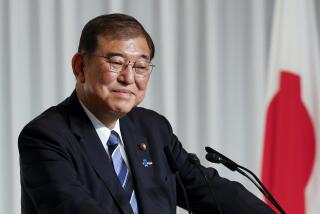Election Preview : Japan at a Crossroads : The Governing Party’s 38-year monopoly on power is at stake in Sunday’s parliamentary elections.
TOKYO — Voters Sunday will have an opportunity like none before to carry out change in Japan in the most important election since World War II.
An unprecedented political setting has emerged. By all political readings, a historical upset will occur. The new factors include:
* Rebel conservative politicians have bolted the Liberal Democratic Party, slashing its holdings to 29 seats below a majority in the powerful lower house of Parliament, which elects the prime minister.
* President Clinton has declared that the United States welcomes change in Japan, assuring voters that relations with Washington will not suffer if the Liberal Democrats are defeated.
* The end of the Cold War has made the Liberal Democrats’ old role as a bulwark against communism superfluous.
* Disgust over corruption has reached new heights.
* Anger burns anew over the Liberal Democrats’ refusal to reform themselves or Japan’s political system.
* And for the first time a conservative opposition has emerged to replace the left-leaning Socialists as a potential receptacle for protest against the Liberal Democrats’ 38-year grasp on power.
BACKGROUND: Four years ago, the Liberal Democrats lost their control of the upper house in a voter rebellion against an unpopular 3% consumption tax and rage over a stocks-for-favors scandal. Since then, the party has been forced to bargain, bill-by-bill, to enact legislation. Delays of as long as 21 months have occurred.
But a defeat in the lower house opens a new ballgame. There, the prime minister is elected. And there rests the power of government spending and foreign policy.
An explosion in Parliament on June 18 triggered the election. After two months of debate over proposals to reform Japan’s electoral system and tighten controls on political funds--prompted in part by mounting reports of multimillion-dollar bribes paid to key politicians--the opposition offered a compromise for reform.
But the ruling party refused any compromise, despite a pledge by Prime Minister Kiichi Miyazawa to get reforms enacted. Ruling party rebels joined the opposition in passing a no-confidence motion against the prime minister, forcing him to dissolve the lower house and call Sunday’s election.
CONTENDING FORCES: Opinion polls conducted by Japan’s major newspapers all have predicted that the Liberal Democrats would fall between 16 and 36 seats shy of a majority.
But, at the same time, seven parties of the opposition may fall short of the seats they need to form a non-Liberal Democrat coalition. The eighth opposition group, the Communist Party, has declared it will not join any coalition. The likely upshot, therefore, is a Liberal Democrat-led coalition.
Such a government probably would carry out far less change than America seeks in Japan. Clinton has made no secret of his desire to see a government in Tokyo that places priority on consumers over producers and on economic growth led by domestic demand rather than by exports. Recent Liberal Democrat governments have pledged to carry out those goals--but have produced few results.
OUTLOOK: No one is yet predicting who the candidates for prime minister will be, nor when the lower house will be convened to choose the country’s new leader.
The constitution requires that Parliament be convened within 30 days of a lower house election. Presumably, the approach of summer holidays will force politicians to speed up procedures. But no deadline is specified by which a prime minister must be elected.
Miyazawa has declared that he will remain in office as president of the ruling party, and his term in that capacity runs through Sept. 30. Until now, the Liberal Democrats have always nominated their president for prime minister.
One other monkey wrench also could be thrown into expected post-election chaos as Japan, for the first time since 1947, goes about establishing a coalition government: The Japan New Party, a grass-roots conservative group campaigning against all established parties, has suggested it might refrain from joining any coalition. If it sticks to that position, Japan could wind up with a “minority government” or a Cabinet lacking majority support in the lower house.
If the first lower house ballot to pick a prime minister fails to produce a majority for any of the candidates, a runoff would be held between the two top vote-getters. Whichever of them wins the most votes--not necessarily a majority--would become prime minister.
PARTIES’ TRACK RECORD
1983 1986 1990 Current* Liberal Democrats 258 304 286 227 Socialists 113 86 141 137 Komei (Clean Government) Party 59 57 46 46 Communists 27 27 16 16 Democratic Socialists 39 26 14 13 **New Liberal Club 8 6 - - Social Democratic Federation 3 4 4 4 Unaffiliated 4 2 5 8 Vacant - - - 15 Total 511 512 512 512***
* Present strength going into elections
** 1976 defectors from the ruling party who rejoined the Liberal Democrats after the 1986 election
*** Because of reapportionments, seats in the lower house have changed; the new lower house will have 511 seats again. The 512 tally shown also includes some relatively recent splinter groups: Renewal Party (36 deputies), New Party Harbinger (10 deputies) and Japan New Party (0 deputies).
LEADERS
Kiichi Miyazawa, 73
(Liberal Democrat President)
A 50-year veteran of government and politics
Sadao Yamahana, 57
(Socialist Chairman)
Ex-left-wing lawyer trying to move leftist party toward middle
Koshiro Ishida, 63
(Komei Party Chairman)
Middle-of-roader now seeking ouster of Liberal Democrats
Tsutomu Hata, 57
(Renewal Party Chairman)
Former junior executive of biggest Liberal Democrat faction who bolted party
Morihiro Hosokawa, 55
(Japan New Party Chairman)
Ex-Liberal Democrat who launched grass-roots protest party
More to Read
Sign up for Essential California
The most important California stories and recommendations in your inbox every morning.
You may occasionally receive promotional content from the Los Angeles Times.










